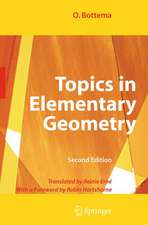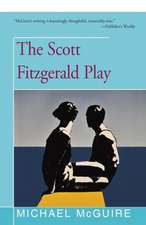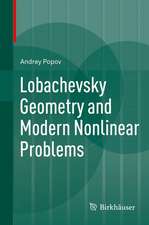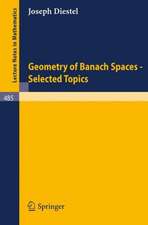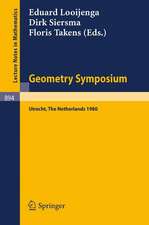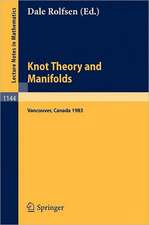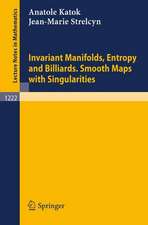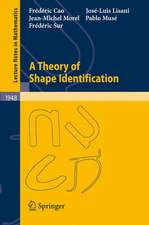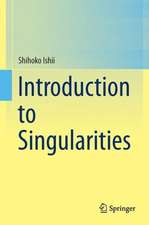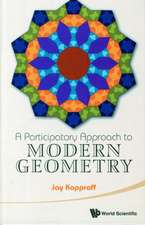The Science of Fractal Images
Editat de Heinz-Otto Peitgen Contribuţii de Yuval Fisher Editat de Dietmar Saupe Contribuţii de Michael McGuire, Richard F. Voss, Michael F. Barnsley, Robert L. Devaney, Benoit B. Mandelbroten Limba Engleză Paperback – 8 oct 2011
Preț: 711.18 lei
Preț vechi: 836.67 lei
-15% Nou
Puncte Express: 1067
Preț estimativ în valută:
136.10€ • 141.28$ • 113.49£
136.10€ • 141.28$ • 113.49£
Carte tipărită la comandă
Livrare economică 24 martie-07 aprilie
Preluare comenzi: 021 569.72.76
Specificații
ISBN-13: 9781461283492
ISBN-10: 1461283493
Pagini: 332
Ilustrații: XIV, 312 p.
Dimensiuni: 210 x 280 x 17 mm
Greutate: 0.82 kg
Ediția:Softcover reprint of the original 1st ed. 1988
Editura: Springer
Colecția Springer
Locul publicării:New York, NY, United States
ISBN-10: 1461283493
Pagini: 332
Ilustrații: XIV, 312 p.
Dimensiuni: 210 x 280 x 17 mm
Greutate: 0.82 kg
Ediția:Softcover reprint of the original 1st ed. 1988
Editura: Springer
Colecția Springer
Locul publicării:New York, NY, United States
Public țintă
Professional/practitionerCuprins
1 Fractals in nature: From characterization to simulation.- 1.1 Visual introduction to fractals: Coastlines, mountains and clouds.- 1.2 Fractals in nature: A brief survey from aggregation to music.- 1.3 Mathematical models: Fractional Brownian motion.- 1.4 Algorithms: Approximating fBm on a finite grid.- 1.5 Laputa: A concluding tale.- 1.6 Mathematical details and formalism.- 2 Algorithms for random fractals.- 2.1 Introduction.- 2.2 First case study: One-dimensional Brownian motion.- 2.3 Fractional Brownian motion : Approximation by spatial methods.- 2.4 Fractional Brownian motion : Approximation by spectral synthesis.- 2.5 Extensions to higher dimensions.- 2.6 Generalized stochastic subdivision and spectral synthesis of ocean waves.- 2.7 Computer graphics for smooth and fractal surfaces.- Color plates and captions.- 2.8 Random variables and random functions.- 3 Fractal patterns arising in chaotic dynamical systems.- 3.1 Introduction.- 3.2 Chaotic dynamical systems.- 3.3 Complex dynamical systems.- 4 Fantastic deterministic fractals.- 4.1 Introduction.- 4.2 The quadratic family.- 4.3 Generalizations and extensions.- 5 Fractal modelling of real world images.- 5.1 Introduction.- 5.2 Background references and introductory comments.- 5.3 Intuitive introduction to IFS: Chaos and measures.- 5.4 The computation of images from IFS codes.- 5.5 Determination of IFS codes: The Collage Theorem.- 5.6 Demonstrations.- A Fractal landscapes without creases and with rivers.- A.1 Non-Gaussian and non-random variants of midpoint displacement.- A.1.1 Midpoint displacement constructions for the paraboloids.- A.1.2 Midpoint displacement and systematic fractals: The Takagi fractal curve, its kin, and the related surfaces.- A.1.3 Random midpoint displacements with a sharply non-Gaussian displacements’ distribution.- A.2 Random landscapes without creases.- A.2.1 A classification of subdivision schemes: One may displace the midpoints of either frame wires or of tiles.- A.2.2 Context independence and the “creased” texture.- A.2.3 A new algorithm using triangular tile midpoint displacement.- A.2.4 A new algorithm using hexagonal tile midpoint displacement.- A.3 Random landscape built on prescribed river networks.- A.3.1 Building on a non-random map made of straight rivers and watersheds, with square drainage basins.- A.3.2 Building on the non-random map shown on the top of Plate 73 of “The Fractal Geometry of Nature”.- B An eye for fractals.- Dietmar Saupe.- C A unified approach to fractal curves and plants.- C.1 String rewriting systems.- C.2 The von Koch snowflake curve revisited.- C.3 Formal definitions and implementation.- D Exploring the Mandelbrot set.- B An eye for fractals.- Yuval Fisher.- D.1 Bounding the distance to M.- D.2 Finding disks in the interior of M.- D.3 Connected Julia sets.


